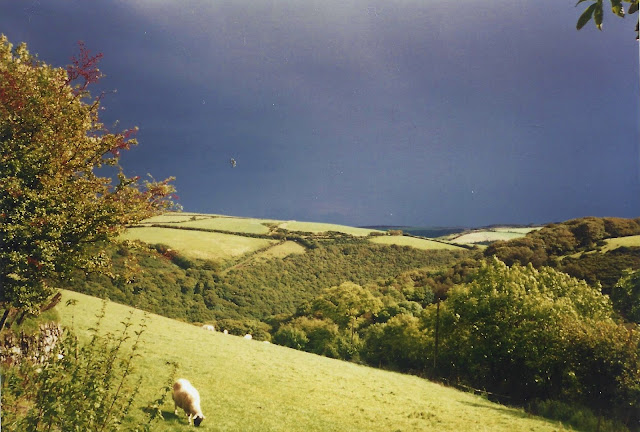Genealogy is relatively easy. Records tell us names, dates, places and relationships. What's harder is understanding the daily lives of our ancestors. An individual's life must be extrapolated, extracted and guessed at. From tiny moments in time and volumes of information that may or may not apply, we try to fill in the blanks of decades of life. The farther back in time we go, the smaller the clues and the more removed we are from understanding how a person might think, feel and live.
As we take an ancestral step back to the 18th century, we shift from Combe Martin, birthplace of my great grandfather, to Brendon, the place where George Norman, my second great grandfather, was christened.
 |
| Proceeding sheepishly in Brendon |
Even to the present day, Brendon is quite rural, but of course, there is always a church and we come to our first snapshot of George. He was christened in this very church in 1783.
 |
| Parish church at Brendon in a moment of sunshine |
 |
| Entry in the Brendon parish register 1783. |
Here's another view of the church, the tiny figure is Lenore getting soaked in the rain.
(For those who are traveling with me to Devon, this photo was taken on 24 September 1999, when I noted that it was "rainiest day yet"! Be prepared. Also, now that I'm looking closely at this picture, I'm wondering if the little blue spot farther down the hill is Jeff.)
As is typical for this time period, virtually nothing is known about George's young life. He had an older sister, a younger sister and a younger brother. When his younger sister, Mary, was christened, there is a notation that his father was a pauper.
There is no such notation for any of the other children. Was this a temporary condition of the family or an ongoing issue that was simply not noted again?
Zooming forward to our next snapshot, the 1841 census, George is living in the village of Combe Martin and is married to "Mary." He was a farmer, and well enough off that he employed a servant by the name of Mary Pugsley. (Are you beginning to think that everyone is named Mary?)
Census day in 1841 was 7 June and by the end of July, George's wife had died of a "paralytick seizure." There seems to be some controversy about the identity of this Mary and whether she had children or not. I (and others) have been unable to resolve this mystery by resort to the parish registers. I am suspicious, though, that the mysterious first wife is Mary Cutcliffe.
George quickly remarried another Mary, Mary Radley. (Getting ridiculous, isn't it.) This marriage is unusual for a few reasons. First, George was 58 and Mary Radley was 29 when they married on 15 December 1841. Note that this is less than 6 months after George's first wife passed away.
The other interesting thing is that they were married by license. Most people were "married by banns" rather than by license. Banns are notices of the couple's intention to marry, read out in the church for the three Sundays prior to the wedding. The choice of banns over a license was most often due to the cost of obtaining a license.
I have read of three supposed reasons for obtaining a license: impatience - no waiting for three weeks while the banns are read; privacy - avoidance of the publicity of the banns; and pride - a status symbol for those that could afford it. We can only guess if any or none of these reasons tell us why George and Mary chose to wed by license.
 |
| George Norman |
This union produced four children, including the youngest child,
Richard Norman, who was not quite a year old when the 1851 census was taken. George at that time was "a farmer of 24 acres" with a man working for him, had a "house servant" by the name of Eliza Watters and resided in a place in Combe Martin identified only as "Holmes." By the 1861 census, George was 78 and was down to 20 acres. George didn't make it to the 1871 census, but left his last snapshot: a certificate in 1870 that records his death of "natural decay" at the age of 86.
From these tiny bits of information, we can piece a few things together. Is there more? I'd love to find out. But we still won't have even "a hundredth part" of the life of George Norman (although I hope we are done with people named Mary).





















